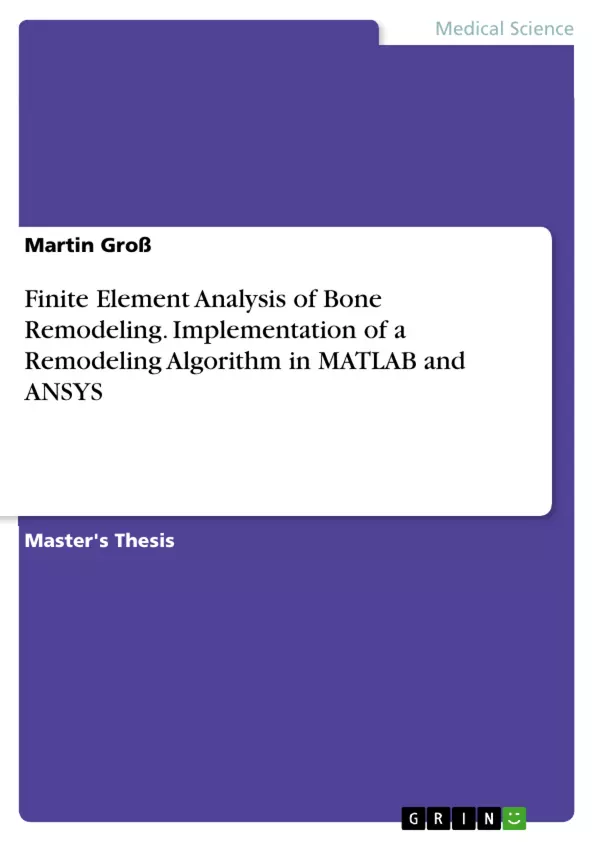The process of adaptive bone remodeling can be described mathematically and simulated in a computer model, integrated with the finite element method. The main focus of this thesis is the implementation of a bone remodeling algorithm in MATLAB and ANSYS on the basis of FEM. The strain energy density is used as mechanical stimulus. The cortical and trabecular bone are described as continuous materials with variable density. This thesis can be divided into four main parts. The first part is due to the material properties of cortical and trabecular bone. The second part is about the remodeling theory and gives an historical review of the developed numerical approaches up to now. The implementation of the remodeling algorithm in ANSYS and MATLAB as well as its validation is topic of part three. In last main part, the algorithm is applied to a 2D FE-model of a human proximal femur.
Inhaltsverzeichnis (Table of Contents)
- Abstract
- Preface
- 1 Introduction
- 2 Material Properties of Bone
- 2.1 Cortical Bone
- 2.2 Trabecular Bone
- 3 Remodeling Theory
- 3.1 History of Bone Remodeling
- 3.2 Mechanical Stimulation
- 3.2.1 Strain Energy Density
- 3.2.2 Strain Rate
- 3.3 Remodeling Algorithm
- 4 Implementation of the Remodeling Algorithm
- 4.1 FEM Program
- 4.2 Remodeling Module
- 4.2.1 Implementation in ANSYS
- 4.2.2 Implementation in MATLAB
- 4.3 Validation
- 5 Application of the Remodeling Algorithm
- 5.1 2D FE-Model of a Human Proximal Femur
- 5.2 Simulation Results
- 6 Discussion and Conclusions
- References
Zielsetzung und Themenschwerpunkte (Objectives and Key Themes)
This thesis explores the process of adaptive bone remodeling, aiming to implement a bone remodeling algorithm in MATLAB and ANSYS using the finite element method (FEM). The strain energy density is employed as the mechanical stimulus, and both cortical and trabecular bone are modeled as continuous materials with variable density. Key themes of the thesis include: * **Material properties of bone**: Understanding the distinct properties of cortical and trabecular bone, including their density and mechanical behavior. * **Bone remodeling theory**: Reviewing the historical development of numerical approaches to bone remodeling, including the role of mechanical stimuli in driving bone adaptation. * **Implementation of the remodeling algorithm**: Describing the development and validation of the algorithm in ANSYS and MATLAB, highlighting the integration with the FEM. * **Application of the remodeling algorithm**: Demonstrating the application of the developed algorithm to a 2D FE-model of a human proximal femur.Zusammenfassung der Kapitel (Chapter Summaries)
* **Chapter 1: Introduction**: This chapter introduces the concept of adaptive bone remodeling and its significance in biomechanics. It highlights the objective of the thesis, which is to implement a bone remodeling algorithm in MATLAB and ANSYS. * **Chapter 2: Material Properties of Bone**: This chapter provides a detailed analysis of the material properties of both cortical and trabecular bone. It examines their density, stiffness, and other mechanical characteristics relevant to bone remodeling. * **Chapter 3: Remodeling Theory**: This chapter delves into the theoretical framework of bone remodeling. It reviews the historical development of numerical approaches to modeling bone adaptation and discusses various factors influencing bone remodeling, including mechanical stimuli, bone cells, and biochemical processes. * **Chapter 4: Implementation of the Remodeling Algorithm**: This chapter describes the implementation of the bone remodeling algorithm in both ANSYS and MATLAB. It highlights the integration of the algorithm with the finite element method, discusses validation procedures, and presents key aspects of the algorithm's functionality. * **Chapter 5: Application of the Remodeling Algorithm**: This chapter presents the application of the developed algorithm to a 2D FE-model of a human proximal femur. It describes the simulation setup, provides a detailed analysis of the results, and explores the implications of the simulations for understanding bone adaptation.Schlüsselwörter (Keywords)
This thesis focuses on the interaction of biological processes and mechanical stimuli in bone remodeling. Key terms include: bone remodeling, finite element method, strain energy density, mechanical stimulus, cortical bone, trabecular bone, ANSYS, and MATLAB.- Citation du texte
- M.Sc.(TUM) Dipl.-Ing.(FH) Martin Groß (Auteur), 2006, Finite Element Analysis of Bone Remodeling. Implementation of a Remodeling Algorithm in MATLAB and ANSYS, Munich, GRIN Verlag, https://www.grin.com/document/113199



